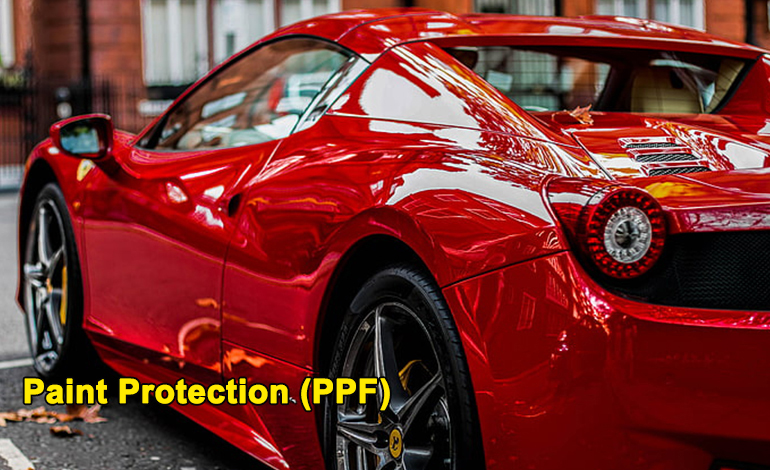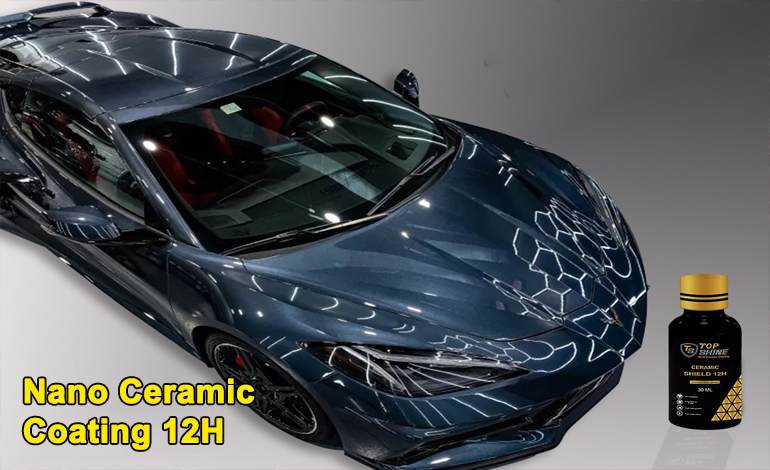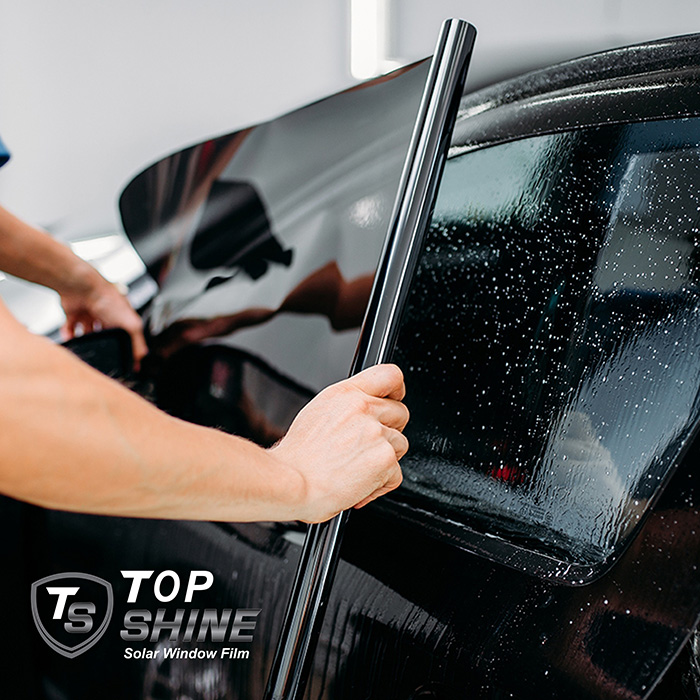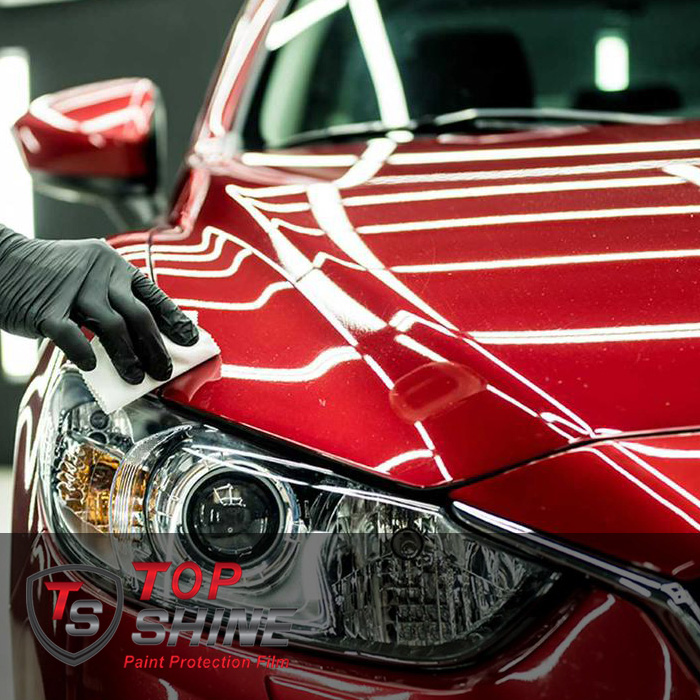WHY TOP SHINE
FILM PROPERTIES
The ability to heal is an advanced feature inside the film’s coating called thermoplastic polyurethane (TPU), a flexible thermoplastic layer that can self-heal once damage occurs. Slight abrasions, scratches or outdoor hazards can be easily averted with these time-tested products.

All About
Paint Protection Films (PPF)
When choosing the ideal protection for your car’s paint, there are several directions in which you can go. When a car’s paint fades, peels or chips away, it not only damages its aesthetics, but also reduces the car’s resale value. Paint protectants are essentially designed to serve as an effective..

Introduction
When choosing the ideal protection for your car’s paint, there are several directions in which you can go. When a car’s paint fades, peels or chips away, it not only damages its aesthetics, but also reduces the car’s resale value. Paint protectants are essentially designed to serve as an effective frontline defense mechanism against environmental debris. Paint protection films or PPFs, take the brunt of the foreign object and environmental damage, such as rock chips, scratches, bird droppings, leaves, UV rays and abrasive chemicals. This ensures that your car has a showroom finish, for a long time. So here’s all there is to know about what PPF is and how it works.
Fun Fact: Paint protective films were not originally intended for civilian use! These films were created to protect defense helicopters from significant damage caused by debris and shrapnel during wars. The protective film gained the nickname of ‘heli tape’, a protective film with a dull, opaque sheen, used by the military. Today PPF is used primarily on automobiles and offers a clear protective surface.
All About Paint Protection Films (PPF)
To break it down into nuts and bolts, paint protection films are fine sheets of thermoplastic polyurethane(TPU) that are extensively used for automotive protection. Once applied, they shield the cars from abrasions caused due to fine debris, paint swirls, bug splatters, stains and in turn, increase the surface durability multifold.
Urethane is transparent and lightweight like plastic but isn’t brittle. Moreover, some PPFs in which the top layer is made of elastomeric polymers, have a ‘self-healing’ property. It means that even if a minor scratch appears on the film, mending and restoration of the texture happens automatically, either instantly or just a few hours in the sun can ‘heal’ the scratches!
The best paint protection film is resistant to corrosion, chemical degradation, and oxidation subject to exposure to sunlight. In simple words, PPF is a clingy, transparent film that effectively protects your car’s showroom finish. You can think of it as a cosmetic security for your car!
In a cohort of car detailing experts, you might hear terms like Clear Bra, Clear Mask, Clear Wrap, and so on, but they all refer to Paint Protection Film. It is better to be informed that the application of PPF is not D-I-Y friendly, in all cases. It can be self-applied on certain smaller parts of the car, such as door edges. But applying it to large areas can be a bit of a challenge, without expert help.There are detailing shops that will wrap your car or apply custom-cut films to the parts of your car you want to safeguard. These parts include windshields, bonnets, boot ledge, or bumpers.
Provided it’s properly installed, the wrap can last from 5-10 years. If this isn’t enticing enough, then what is? No doubt, PPFs only have a protective function but who wouldn’t wish to see his car immaculate and nothing short of a showroom finish, for as long as he owns it!
However, not all PPFs are the same. The quality of a PPF is based on the type of TPU used in the making. If your protective wrap is made from aliphatic TPU, then know that you have made the right call but if made from aromatic TPU, then you should give a second thought to it. To help you make an informed choice we will cover the topic in detail in one of the following sections of this article.
Do You Need A PPF?
Buying a car is a pretty significant investment. Even a tiny scratch on your car, whether old or new, really hurts. Driving around with even the slightest discoloration, is a constant reminder of neglected maintenance. If you want to drive with a peace of mind, then PPF is the way to go!
While an extra protective film is an add-on as per your preference, it offers some great benefits that will keep your cherished car in top shape for a long time. These paint protective films aid in value retention and maintaining the sleek ‘new car look.’
They do not add any mechanical value to your car, but they protect the car paint from scratches, fading due to heat, and other debris. You may want to consider a paint protective film, especially if your car is exposed to the following situations:
- If you park your car in an area with a lot of trees, it is an excellent option to opt for a paint protective film, to protect your car from birds, fruits, and other natural debris.
- If your car is prone to scratches, due to designated parking in tight spots for long periods.
- If you frequently have a long-distance commute, flying stones and gravel may chip away your car’s paint. To avoid the added expense of repainting your whole car, you may want to consider a paint protective film.
Benefits offered by PPF
Needless to say, paint protection films hold the crown in providing car owners with one of the most efficient means of automotive protection. The physical and chemical properties of the substance enable it to safeguard the cars wrapped in it. Without much ado, let’s wade through some of its benefits in detail:
- High Impact Resistance: PPFs have high impact resistance which imparts protection against scratches due to flying debris.
- Chemical and Corrosion Resistance: PPFs are resistant to chemical contaminants and corrosion. This defends the car’s surface against staining and yellowing from mineral deposits, acid rain, bird droppings..
- UV Protection: PPFs shield your car’s paint from harmful UV rays, hence preventing it from being oxidized. Therefore, it waives the worry of the paint fading due to UV rays.
- Impressive Optical Clarity: Since it is extremely lightweight, thin, and transparent, it will provide complete protection without veiling your car’s original color and shine.
- High Durability:It has commendable longevity. If applied properly, the lamination can last for 5-10 years.
- Hydrophobicity: PPFs repel water, just like ceramic coatings, reducing the occurrence of water spots.
- Easy to Maintain: PPFs are super easy to clean, and are also anti-graffiti.
So leave your worries of maintenance behind with PPF and revel in its benefits!
Which PPF is Better?
As discussed above, PPFs made from aliphatic TPU have an edge over those made from aromatic TPU. This is due to a slight change in their chemistry which brings about a massive difference in their behaviors under different conditions.
Aliphatic TPU lends commendable stability to the materials. It does not undergo oxidation under UV rays or degrade under chemicals that normally damage films made from aromatic TPU. Therefore, it shows no change of color(yellowing) over an impressive period of time.
Unlike aromatic TPU coatings, aliphatic TPU coatings are much more resistant to surface abrasions and can stand harsh weather conditions. This obviously implies that your car laminated with an aliphatic TPU PPF will have a greatly enhanced surface durability.
Moreover, in contrast to aromatic TPU, PPFs made from aliphatic TPU are hypoallergenic and odorless making them extremely customer friendly. We hope that you now know what to treat your car with! So now, be sure to look before you leap.
Key Takeaways
Paint protection films are a brilliant way to shield a vehicle’s surface, from abrasive debris such as rock chips, bird droppings, bugs, and leaves. The effective film aids in protection against scratches, UV damage, oxidisation, and paint swirls. Its self-healing properties and durability are worth investing in, to keep your invaluable car looking sleek and new for longer. Top shine provides some of the best paint protective films in the world . So bid adieu to water spots and chipped off paint, and welcome an top shine PPF product, available at your nearest car detailing service, today!

Solar Window
Film Protection
Be it rain or sunshine, your car’s window Film combats harsh weather elements, and protects the car’s occupants from rocks, twigs, water, and dirt. When a piece of rock hits the window Film, and leaves a scratch, you’re left with a sinking feeling of doom that your precious car is no longer perfect..

Solar Window Film Protection!
Be it rain or sunshine, your car’s window Film combats harsh weather elements, and protects the car’s occupants from rocks, twigs, water, and dirt. When a piece of rock hits the window Film, and leaves a scratch, you’re left with a sinking feeling of doom that your precious car is no longer perfect.
It is therefore important to take complete care of your window Film. The easiest way to do so, is by installing a window Film protection film.
What is a solar window Film?
A solar window Film is a thin, transparent film applied to the window Film glass to protect it from rock chips, stones, or other flying debris that one encounters while driving. Unlike glass, which is brittle and fails to absorb the impact of the incoming objects while driving, window Film defenders, being made of a material softer than glass, are easily able to do so.
A window Film protection film consists of three layers. The uppermost layer is the protective coat which defends the window Film against scratches from flying rocks and damage due to UV and chemicals.
The middle layer is made up of a polymer that absorbs the incoming debris’s impact and distributes the force to prevent the glass from breaking. The lowermost layer is the adhesive layer, with the help of which the film sticks to the window Film glass. It also assists in shock absorbance.
When applied properly, the window Film defender remains completely unnoticeable. If you are worried about your vision being hindered, then let us tell you not to faze since it is optically clear.
Is a solar window Film Worth It?
Replacing your window Film is not an easy task and can be pretty annoying. You’ll have to find the perfect vendor, dedicate hours of your busy schedule to get it replaced, and most importantly, spend quite a hefty amount on a window Film that can easily get damaged again.
It’s time to look into a window Film defender if you can relate to any of the following:
- If you own a luxury vehicle: Luxury vehicles have expensive maintenance costs, and replacing the windshield can be quite pricey. Moreover, t flat window Films are vulnerable to rock chips, and may need frequent replacement.
- If you love off-roading or adventure trips: The key to a worry-free trip lies in protecting your window Film from flying debris and rock chips. With a window Film defender, you can enjoy your adventure, even if faced with poor road conditions!
- If you love your car and want to ensure maximum protection: To protect your loved ones, and drive with peace of mind, it is important that the window Film is always in top-notch shape.
The most ideal solution? Install a high-class window Film protection like the top shine solar window Film . Not only will this give you extra insurance and an added advantage over the environmental elements, but you will be able to drive with peace of mind!
Benefits Of a solar window Film
Although there is not a speck of doubt about the windshield defender being important for automotive protection, let’s dive a little deeper and get an insight into how exactly it safeguards your car’s windshield.
- Defends against scratches: Stone chips, weather elements like snow, hail, and falling objects like leaves and twigs are potential threats to your car’s windshield. The build-up of scratches on the windshield obstructs the driver’s vision. A windshield defender’s application rules out massive possibilities of danger since it effectively protects the windshield from scratches.
- Protects from sun damage: Throughout the year, UV rays pose an inevitable threat to your car. In such cases, a windshield defender comes to the rescue. The top layer of a windshield protection film comprises a special reflective material that combats damages caused to the car’s interior by UV rays.
- Regulates temperature: During winter, the windshield protection film insulates the glass, thereby preventing heat dissipation. Hence, even after your car is turned off, the heat from the vent will be maintained to give you warmth and comfort. During summer, the reflective outer layer reflects the scorching sunlight and maintains a decent temperature inside the car.
Choosing The Right solar window Film
A variety of windshield protection films are available in the market. This demands one to be well aware of the products so that an informed decision can be made on choosing the windshield defender that can ensure maximum protection.
Top shine windshield defender is a completely transparent, optically clear film, deliberately designed to protect your car’s windshield without interfering with your vision while driving. It provides optimum protection against stone chips and other environmental elements that can cause lasting damage to the car’s windshield.
The fine film can block UV rays and is water repellent. One of the most striking features of the top shine Windshield defender is its ability to self-heal from minor scratches and abrasions. Besides, its ease of removal enhances its convenience and makes it a stronger choice.
So, before taking the vital step of picking a windshield defender for your car, make sure that all the boxes are checked!
Final Verdict
At the end of the day, choosing the right windshield protection film depends on your expectations, lifestyle, and driving habits. If you drive regularly and want to relieve yourself from the stress of maintenance, choosing a durable, scratch-resistant, and self-healing film will give you the extra longevity for your car as desired.
The top shine Windshield Defender is a perfect choice, as it fulfils all the requirements that a good windshield protection film should have, including durability, scratch-resistance, optical clarity, and UV protection.
Now that you’re equipped with all there is to know about windshield defenders, you’re ready to make a decision that works best for your car and you!

Working Principles of Nano Coatings
Nanotechnology is the umbrella term for all activities conducted at the invisibly small nanoscale, applied to various disciplines such as chemistry, technology, engineering, and many others The fundamental structures of nanotechnology are nano-particles..

Working Principles of Nano Coatings
What does “nano” mean? What is nanotechnology? What are its purposes, which industries is it applied to?
“Nano” is a prefix that refers to one-billionth of any unit. For example, one meter is made up of one billion nanometers.
Nanotechnology is the umbrella term for all activities conducted at the invisibly small nanoscale, applied to various disciplines such as chemistry, technology, engineering, and many others. The fundamental structures of nanotechnology are nano-particles, which are as small as 100 nanometers or less. The manipulation and design of matter conducted at this scale—which is about 1/80,000 the width of a strand of human hair—is nanotechnology’s main field of study.
Nanotechnology is applied to many industries ranging from medicine to engineering, from chemistry to agriculture. While nanoparticles can be utilized for the diagnosis and treatment of certain medical conditions, it is also predicted they can be applied to the field of sustainable energy to provide eco-friendly solutions. Furthermore, nanotechnology is widely used in the industrial sector and the manufacture of end products.
To mention a few examples of the role nanotechnology plays in our daily lives; it prolongs the lifespan of food packaging, makes it possible for electronic devices to be lighter in weight, increases the resistance of sunscreens to UV rays, strengthens artificial bones, and improves the durability of vehicle surfaces against external factors.
What are nanotechnological nanocoatings?
Nanocoatings are invisibly thin layers developed in light of the principles of nanotechnology. When surfaces are covered in these layers, they gain various properties. Some of these are:
- Water and oil repellency
- UV resistance
- Resistance to various issues such as scratches, impact, mold, fading, and oxidation
- Prevention of bacterial growth
- Resistance to harmful chemicals
Due to these properties that improve the functionality of treated surfaces, nanocoatings are widely applied to a range of materials, products, and structures with the aim of prolonging their lifespan and increasing their ease of use.
What are the benefits of nanocoatings?
Surfaces that are treated with nanocoatings gain various qualities such as liquid and stain repellency or resistance against scratches and chemicals, depending on the nature of the material. Thanks to these qualities, consumers can use nanocoating-treated products more easily and smoothly, prolong the lifespan of their personal belongings or home/vehicle surfaces, and increase the financial efficiency of their purchases. These products, which become much easier to clean due to the nanocoating application, gain durability against various damaging factors, hence decreasing the time and effort consumers put into the cleaning and product care processes. Valuables and personal belongings remain in a good condition for a longer time while their value is increased.
What are hydrophobic coatings and the lotus effect? How are nanocoatings used for this purpose?
Hydrophobia, in this context, refers to water repellency. Surfaces that are treated with nanocoatings become hydrophobic. This way, treated surfaces repel liquids, become easy to clean, and remain stain-free.
As for the lotus effect, it is a term named after the lotus flower, which is very similar to the widely known waterlily. The aquatic lotus plant is known for its liquid and dirt-repellent leaves. This hydrophobic quality, which is also observed in other plants such as wheat and corn, helps leaves and petals to remain clean. As the surface structure of nanocoatings is inspired by the natural structure of these plants, the water repellency and easy cleaning qualities with which they provide treated surfaces are known as the lotus effect.
Nanocoatings can be applied to various surfaces for this purpose, including—but not limited to—textile, glass, ceramic, metal, wood, and natural minerals. They prevent precious clothing items and footwear from getting dirty and stained, as well as providing vehicle surfaces, wooden furniture, boat decks, and many other surfaces we use in our daily lives with hydrophobic properties and lotus effect.
What are the harmful effects of UV rays on various surfaces? How are nanocoatings used for this purpose?
Just like the human body, surfaces can also be harmed by UV rays. When materials that are not UV-resistant are exposed to these rays for an extended period of time, some negative outcomes such as discoloration, fading, cracking, disintegration, sunburns, breakage and loss of flexibility can be observed. These damages are generally called UV degradation.
Many types of natural and synthetic materials widely used in our daily lives are prone to UV degradation. Nanocoatings that offer UV protection can be used to prevent sun damage in various products and structures, especially those made of rubber, wood and PVC. These types of nanocoatings are specifically developed with the aim of protecting surfaces against UV degradation.
When UV-protection nanocoatings are applied to surfaces that are frequently exposed to sunlight, this invisible layer acts as a shield and prevents problems such as fading, wear, and cracking. Nanocoatings are widely applied to wooden furniture, textiles and leathers, boat surfaces and vehicle paintwork for this purpose.
What are stain repellency and easy-to-clean properties? How are nanocoatings used for this purpose?
As surfaces treated with nanocoatings become liquid and dirt-repellent, stain formation is prevented and the cleaning processes of these surfaces become easier. Even materials that typically cause the toughest stains cannot be absorbed into the deeper layers of the surface thanks to the nanocoating that acts as a shield, hence sliding right off the surface. Due to the hydrophobic properties and the lotus effect created by the nanocoating, dirt cannot bond to the surface and is easily wiped away without requiring traditional cleaning processes.
Nanocoatings are widely used for this purpose on textile products, car care and detailing procedures, personal belongings and home surfaces. For instance, suede shoes treated with a nano textile protection product can simply be wiped clean even after being exposed to dirt and mud. The same principle applies to nano vehicle surface protection products; they form a durable, long-lasting layer over the paintwork, preventing external factors such as rain, mud, lime, hard water, bird droppings, chemicals and gravel from forming stains and damaging the surface.
In which industries are nanocoatings used, and for which purposes? How do nanocoatings work?
Nanocoatings are applied to many industries for the protective layer they form over various surfaces.
In the textile and retailing industries, they are used to protect textiles and fabrics against stains, fading, wear and tear, wrinkles, UV damage, and bacterial growth. In automotive and marine industries, nanocoatings protect treated surfaces from liquids, moisture and UV rays, preventing issues like oxidation, corrosion and scratching. Similarly used on furniture, home surfaces and personal belongings due to their liquid and stain repellency, easy-to-clean properties, chemical and scratch resistance; nanocoatings offer much more effective and long-lasting performance with a smaller amount of product when compared to standard coatings.
Nanocoatings contain extremely small particles measured at the nanometer scale. This is how they form a much thinner layer over treated surfaces than standard coatings; this protective layer is invisible to the human eye and does not affect the texture or appearance of the surface in any way. The layer alters the surface energy of the treated material, providing it with properties such as liquid repellency, stain resistance, easy cleaning and durability to various damaging factors. This way, nanocoatings prolong the lifespan, facilitate the use, as well as increase the functionality and value of the end products to which they are applied.












